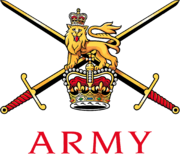British Army
Not to be confused with English Army
| British Army | |
|---|---|
 | |
| Active | January 1, 1660 |
| Country |
|
| Type | Army |
| Role | Land warfare |
| Size |
82,040 active personnel (2021) 3,960 Gurkhas (2021) 29,740 reserves (2021) |
| Part of | British Armed Forces |
| March | List of marches of the British Armed Forces |
| Commanders | |
| Commander-in-chief | Queen Elizabeth II of Britain |
| Chief of the General Staff | General TBD |
| Deputy Chief of the General Staff | Lieutenant General TBD |
| Army Sergeant Major | Warrant Officer Class 1 TBD |
| Insignia | |
| War flag |
 |
| Non-ceremonial flag |
 |
| Logo |
 |
The British Army is the principal land warfare force of the United Kingdom and is one of the three main branches of the British Armed Forces along with the Royal Navy and Royal Air Force. As of 2021, the British Army has a total of 82,040 active duty personnel along with 29,740 personnel in the Army Reserve and 3,960 Gurkha soldiers.
The modern British Army traces its rutes back to the ascendants of the English Army and Scots Army that were merged to create one unified fighting force during the Restoration of 1660. In wouldn't be until 1707 with the Acts of Union between England and Scotland that the term British Army would be formally adopted. Members of the British Armty give a formal swear of allegiance to the monarch as the army's ceremonial commander-in-chief, however both the Bill of Rights of 1689 and the Claim of Right Act 1689 both require parliamentary consent for the Crown to maintain a standing army. In practice, this results in Parliament passing an Armed Forces Act at least once every five years. The army is administered by the Ministry of Defence and is overseen by the Chief of the General Staff as its overall commander.
The British Army initially composed of two arms; the Regulary Forces composed of the infantry and the cavalry and the Ordnance Military Corps which composed of the Royal Artillery, Royal Engineers, and Royal Sappers and Miners under the administration of the Board of Ordnance and the civilian Commissariat Department. Both were tasked the supply, storing of equipment, as well as the barracks of the army before they were dissolved in 1855 and merged into the War Office. In 1964, the Ministry of Defence was created as a replacement of the War Office which has overseen the army and the rest of the British military since then.
The British Army has seen active combat over the course of over three centuries as one of the world's great powers including the Seven Years' War, the American Revolutionary War, the Napoleonic Wars, and the Crimean War of the 18th and 19th centuries. In the 20th century, the British Army saw action in the First and Second Great War and also saw active combat and deployments throughout the Cold War. Because of their victories and inspite of their defeat, the British Army has prevailed as one of the most formidable armies in the world and has established the United Kingdom as one of the world's foremost economic and military powers. Since the end of the Cold War in 2000, the British Army has seen continued action overseas in various conflict zones, often as an expeditionary force, as part of a coalition, or in League of Nations peacekeeping operations.